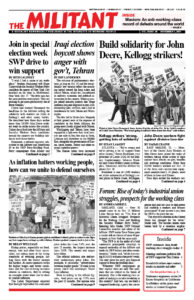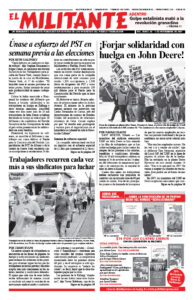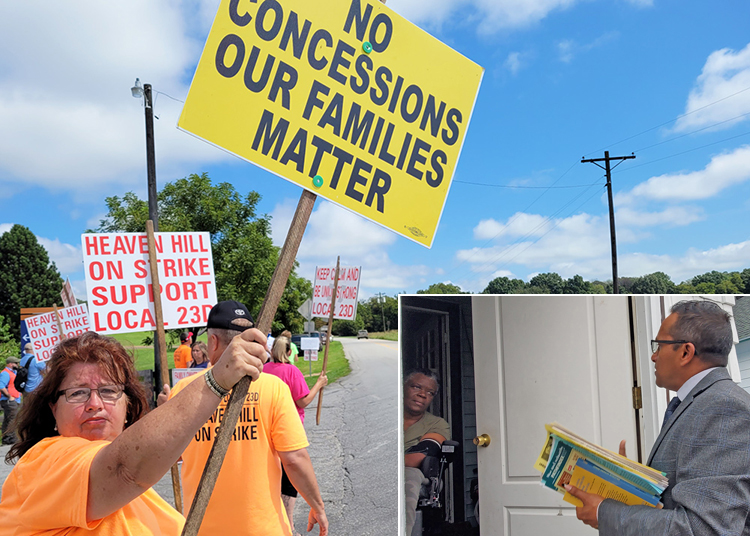OAKLAND, Calif. — Over 30 people came to an Oct. 15 Militant Labor Forum here on “The Rise of Industrial Union Struggles: Prospects for the Working Class and Building the Socialist Workers Party Today,” featuring John Studer, SWP National Committee member and editor of the Militant. SWP leader Dave Prince gave a similar talk at a forum of some 40 participants in New York the same night.
“The SWP is in the midst of a bold communist propaganda campaign to expand readership of the Militant and books by SWP leaders and other revolutionaries,” Studer said, “while also raising $130,000 to finance the party’s work. The only place the party gets financial support is from the working class.”
“Wherever SWP campaigners go they explain there are only two questions that are critical to the future of humanity. One, is the working class capable of making a socialist revolution in this country? And two, can we build a vanguard leadership, a party that can organize and lead our class to take power and establish a workers and farmers government? If your answer is yes, then the SWP is the party for you.
“The objective situation in the United States has changed for the better,” Studer said. “For decades unions were beaten back by a relentless employers’ offensive, all too often facilitated by the class collaborationist course of our trade union leadership. Today only 6.3% of workers in private industry are in unions, a lower percentage than before the explosion of union battles and the rise of the CIO in the 1930s.”
Things are changing
“But things began to change in 2018,” he continued, when a series of teachers strikes swept across the country, starting in West Virginia, where their battle was marked by the spirit of past class struggles by the United Mine Workers.
Then in 2019 the largest number of industrial workers went on strike in 35 years, Studer said, including 49,000 United Auto Workers at General Motors; 31,000 United Food and Commercial Workers at Stop & Shop stores on the East Coast and 20,000 members of the Communications Workers of America at AT&T.
This was cut off in 2020 by the rulers’ lockdowns imposed in the name of fighting the pandemic, Studer explained, but picked up again in 2021, beginning with 1,400 Teamsters striking Hunts Point Produce Market bosses in New York. This has been followed by the continuing coal miners strike against Warrior Met in Alabama; Volvo Truck workers, who three times voted down “deals” that didn’t meet what they felt they deserved; and hard-fought strikes by the Bakery, Confectionery, Tobacco Workers and Grain Millers union at Frito-Lay, Nabisco and 1,400 workers currently on strike against Kellogg’s. Now more than 10,000 UAW members are out at agricultural implement giant John Deere.
Workers all across the country — and the boss press — are watching these battles, Studer said. They want to know how to fight effectively and win. Big questions are posed: how to overcome divisions the bosses foster, how to break through press blackouts and win over public support, how to find ways to shut production down.
The bosses work overtime trying to divide us — by race, sex, nationality, immigrant against native-born, employed vs. unemployed. They try to make competition among workers a defining condition of life. For example, Studer said, Deere bosses are trying to pit farmers against the workers because the strike comes at harvest time.
“But our fights against the employers and their government teach the opposite,” Studer said. “We learn that workers all face a common enemy. We need to unite to confront their attacks. This opens the door to strengthening and using our unions.
“Many workers have been living under worsening conditions, as bosses push to place the crisis of their capitalist system, exacerbated by the pandemic, on workers’ backs,” Studer said. “They’re convinced there must be a road forward out of the social catastrophes and brutal conditions they see around them.”
Workers increasingly see that the bosses’ parties, the Democrats and Republicans, don’t represent them. They are ready for serious discussions and open to the party’s program. This is why the goals in this fall’s drive are higher than before. The Militant and our books contain lessons from the class struggle many are reaching for.
“The bosses are concerned that our class has an edge today. They’re trying to figure out how to advance their interests at home and abroad under these circumstances. But they are driven to attack our class, there is no other way they can defend themselves against their competitors and make profits. The working class produces all wealth,” Studer said.
“Today’s strikes have similar features. At the beginning of the pandemic, and in the 2008 capitalist crisis before that, workers were told they had to sacrifice to keep the company going, they were ‘essential,’ and that they would be rewarded later. But instead, they face demands for even more concessions.
“These strikes are not primarily about money,” Studer explained. “They are more about schedules: long hours, no overtime pay after eight hours, short turnarounds, and the inevitable deprivation of time for family or even religious practice, as one Kellogg’s worker put it. The building of a fighting union movement becomes a burning question.”
As part of this process, workers become more interested in working-class answers to broader political questions in an increasingly unstable world: growing frictions between imperialist powers, confrontations between Washington and the government in Beijing, conflicts and repression from Myanmar to Iraq, and the potential for broader wars and destruction as the crisis of the capitalist rulers and their states deepen.
There’s also greater interest in social questions, from women’s personal right to choose to have an abortion or not; to the spread of “wokeism” that denies the biological reality of two sexes, women and men; to “canceling” people who disagree. And over police brutality and growing attacks on Jews.
Building a proletarian party today
“The breadth of these discussions shows what is possible for a proletarian party today, both in the unions and with workers in cities, towns and rural areas. It’s a good time for a propaganda drive like we’ve begun, with the possibility to involve others with us. The Militant champions the battles workers need to join in. Our books bring alive the lessons of previous battles. Our program of principled politics grows out of the class struggle going back to Karl Marx and Frederick Engels, the 1917 Bolshevik Revolution, and through the rebirth of communism in the Cuban Revolution of 1959,” Studer said.
“We will talk with working people in cities and rural areas across the country. Some workers consider the term propaganda as suspect, a way to describe capitalist advertising,” Studer said. “But to Marxists, propaganda is getting out the party’s program, the truth about our continuity in revolutionary battles and the class struggle, and our tradition of selfless conduct. No one else offers this today.”


